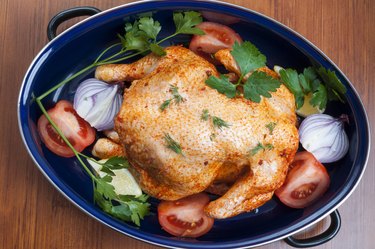
Your selected cooking method affects the taste and texture of food, whether you're working with meat, vegetables or another favorite food. Most foods work with any of the cooking methods, although certain foods are more compatible with one or two ways of cooking. Consider the differences in the method and outcome to select the ideal cooking process for your meal.
Baking
Video of the Day
Baking takes place in the oven using dry heat. This simply means no liquid is used to facilitate the cooking process. Baking is very similar to roasting, but the process of baking often refers to items like pies, cookies, cakes, breads, casseroles and pastries. These are food items that require you to mix together individual ingredients. When baked, they produce a new food item and structure from which you can no longer separate the individual ingredients.
Video of the Day
Roasting
Roasting also occurs in the oven and is considered a dry-heat method. Recipes typically refer to individual food items that are cooked in the oven when they talk about roasting. For example, vegetables and meats are typically roasted as opposed to baked. The roasted food maintains its structure and doesn't turn into something else as it roasts. Roasting may require a slightly higher temperature, but the process can also use lower temperatures. Vegetables are often roasted until they become caramelized, which is characterized by browned areas on the surface.
Searing
Searing is a stovetop cooking method that creates a crisp outer coating on the food. Meat and fish is most often seared. This cooking method is sometimes combined with roasting. The fish is seared on all sides in a skillet with a small amount of oil. Once it is browned all over to seal the outside of the meat, it goes into the oven to finish cooking. The meat requires less cooking time in the oven, which reduces the chances of the meat drying out.
Boiling
The boiling process uses liquid to transfer heat to the food being cooked. The liquid causes the cooked food to have a soft texture rather than a crispy coating. A saucepan or stockpot is filled with enough liquid to fully cover the food being boiled. The liquid is heated to a boil. Water is a common boiling liquid, but broth is another option for many dishes. Once heated to a boil, the food goes into the liquid. Some recipes call for the food to continue cooking at a boil, while others recommend lowering the heat so the liquid simmers. Pasta, grains and vegetables are often cooked with the boiling method.
Braising
Braising is frequently used with meat, fish or vegetables. This method also uses a liquid, but it doesn't use as much liquid as boiling. Common braising liquids include broth, wine or stock. The food is not fully covered. Instead, a small amount of liquid is added and the food is cooked over low heat for a longer time. Braising helps tough cuts of meat become tender. In most recipes, the braising liquid is cooked out of the dish by the end of the cooking time. Some recipes may also start by searing the food before the braising liquid is added. This results in a crispier finish than you would have only using liquid.